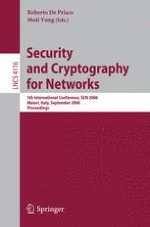The Conference on Security and Cryptography for Networks 2006 (SCN 2006) was held in Maiori, Italy, on September 6-8, 2006. The conference was the ?fth in the SCN series, and this year marked a change in its name (the former name was Security in Communication Networks). The name change meant to better describe the scope of the conference while preserving the SCN acronym. This year for the ?rst time we had the proceedings volume ready at the conference. We feel thatthe SCN conferencehas maturedandthat it has becomea tradition to hold it regularly in the beautiful setting of the Amal?tan coast as a biennial event. Theconferencebroughttogetherresearchersinthe?eldsofcryptographyand security in order to foster the extension of cooperation and exchange of ideas among them, aiming at assuring safety and trustworthiness of communication networks. The topics covered by the conference this year included: foundations of distributed systems security, signatures schemes, block ciphers, anonymity, e-commerce, public key encryption and key exchange, secret sharing, symmetric and public key cryptanalysis, randomness, authentication. The international Program Committee consisted of 24 members who are top experts in the conference ?elds. We received 81 submissions amongst which 24 papers were selected for presentation at the conference. These proceedings - clude the extended abstract versions of the 24 accepted papers and the short abstract of the invited talk by Ivan Damg? ard.
